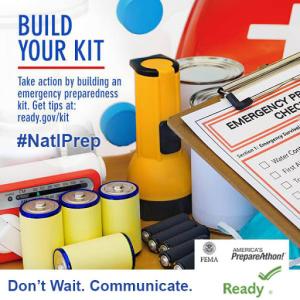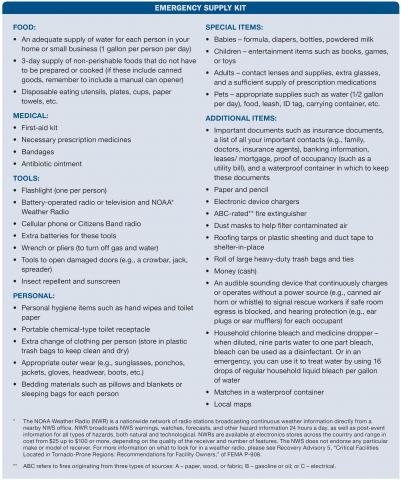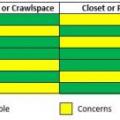Scope
Determine disaster risk and assess options for shelter-in-place to include space planning for emergency supplies storage in new or existing single-family homes. For disaster events where evacuation is not possible or practical, occupants may need to shelter-in-place using a storm shelter, safe room or best available refuge area. Depending on the type of disaster event, it may be necessary for occupants to shelter-in-place for an extended period of time without access to food, water, electricity, and other essentials.
Provide emergency supplies storage for short-term shelter-in-place (<3 days) to include:
- Food and water
- First aid supplies, hand warmers
- Medications
- Sanitation and hygiene supplies
- Clothes and bedding
- Basic hand tools, matches, flashlights
- Battery-, crank- or solar-powered radio
- Important documents
Provide emergency supplies storage for long-term shelter-in-place (>3 days) to include:
- Additional food, water, and personal supplies
- Standby power equipment
- Portable space heating and cooling equipment
- Portable cooking appliances
- Lighting systems
- Drinking water treatment systems
- Power tools and equipment
- Temporary shelter or repair materials
- Portable tables, chairs, and bedding
- Fuel storage
See the Compliance Tab for links to related codes and standards and voluntary federal energy-efficiency program requirements.
Description
For disaster events where evacuation is not possible or practical, occupants may need to safely shelter-in-place using a storm shelter or safe room. If a storm shelter or safe room is not available, occupants may need to shelter in a best available refuge area. Some disaster events such as tornados are generally short-duration events. While damage from tornados may be catastrophic, it is usually limited to a small geographic region. Often, assistance from neighboring communities is readily available to provide temporary shelter and other resources to help those displaced until damage is repaired and basic services are restored. Other disaster events such as hurricanes, earthquakes, and severe winter weather can affect a much larger geographical area for a longer period of time. Because of the scale of these events, assistance may not be available for days or even weeks. In such cases, it may be necessary for occupants to shelter-in-place for an extended period of time. For other events such as a major power outage, chemical or radiological release, or disease outbreak, it may also be necessary to shelter-in-place for an extended period of time to avoid exposure hazards or to maintain social distancing.
Know the Risks
The conditions for shelter-in-place are determined by the types of disaster events that have or are likely to occur in a given community or region. Many areas of the U.S. are vulnerable to many different types of hazards including weather events, seismic activity, and wildfires. Urban areas, where more than 80% of the U.S. population lives, may be vulnerable to other types of hazards such as industrial and transportation accidents or acts of terrorism.
See the Climate Tab for more information on disaster risks by U.S. urban area.
Develop a Plan
Once the types of disaster events that may affect a community have been assessed, a hazard-specific emergency preparedness and response plan can be developed. An emergency preparedness and response plan includes actions taken before, during, and after a disaster event to protect people and property. Emergency preparedness and response plans include actions that will be taken to either evacuate occupants or have occupants shelter-in-place. For events such as an approaching weather system, evacuation is often the safest and most effective strategy. For other events such as wildfires and floods, evacuation is the only option. Other disaster events such as earthquakes and tornados may allow no time for evacuation, requiring occupants to seek shelter in a safe room or refuge area within the home.
The decision to evacuate or shelter-in-place may come with little warning or time to gather even the most basic necessities. For this reason, emergency supply kits for either evacuation or shelter-in-place should be readily available to sustain occupants with food and water, first aid, medicines, hygiene supplies, clothes, and bedding for at least 72 hours (Figure 1). For areas vulnerable to large-scale disaster events which could limit access to electricity for longer periods of time, consideration should be given to space for additional food and water, standby power and fuel storage, heating, cooling, and cooking equipment and other provisions to improve the health, safety, and comfort of occupants.
Homeowners and their contractors or builders may further consider design or retrofit space options for permanent alternative power, energy storage and drinking water treatment systems. Options for permanent alternative energy may include photovoltaic or wind-power systems as well as solar-thermal systems for water heating. In addition to providing backup power, these systems may be used under normal operating conditions to reduce utility costs.
How to Plan for Emergency Supplies Storage
Planning for emergency supplies storage should consider the time that may be needed to restore basic services following a ‘worst-case’ disaster event. Planning should also consider the number of sheltered occupants and the special needs of occupants and pets. Storage should also ensure that supplies and equipment are sufficiently protected and are available to occupants during or following the disaster event. If a safe room or refuge area is used for emergency supplies storage, sufficient space should be provided to ensure adequate access and space for occupants.
Size
A healthy adult needs 2,000 to 3,000 calories from food per day in addition to one gallon of potable water for drinking and basic hygiene. A minimum 3-day supply of non-perishable food consisting of dry grains (3lbs), canned or dried meat (0.5 lb), canned fruit and vegetables (1qt), water (3 gal) and other ready-to-eat foods and eating utensils would require approximately 2-3 cubic-feet of food storage space per person.
In addition to food and water, a 3-day emergency supply kit should include medical supplies (first aid kit and medications), personal supplies (hygiene, clothes, and bedding), basic hand tools and equipment (flashlights, radio, and batteries). Depending on the climate and season, bedding and a 1-day change of clothes may require an additional 2 to 3 cubic-feet of storage space per person. Since emergency supply kits should be accessible, the storage space utilization rate should not exceed 25%. Storage space utilization is the ratio of space used for emergency supplies storage in relation to the overall volume of the storage space. If an adult requires 2-3 cubic-feet of food and water and, another 2-3 cubic-feet for personal supplies, a total of 16-24 cubic feet of storage space would be required for a 3-day emergency supplies kit. Additional space may be required for persons with special needs or care for pets.
Location
The location for emergency supplies storage is often dictated by the size of the space needed for storage. The location of storage should also ensure supplies and equipment are sufficiently protected and are available to occupants during or following the disaster event. Other factors to consider in choosing a location for emergency supplies storage include stable, cool temperature, ventilation, low humidity, no direct sunlight, and protection from pests. Important factors for determining favorable and unfavorable locations for storing emergency supplies are shown in Figure 2.
Basements are usually ideal areas to store emergency supplies. Unfinished basements offer sufficient unused space and may also serve as a protected refuge area for occupants. Basements are usually cool (<70oF) and dark which helps to preserve food. Basements, however, can have high (>40%) relative humidity, and they may be susceptible to pests and could flood during heavy rain or windstorm events. For homes without basements, an interior closet or pantry may offer added protection as well as the ability to control temperature, humidity, and light. Closets and pantries are easily accessible, which can help ensure that food stocks are used and replaced every 6-12 months to avoid spoilage. Available space, however, is often a limiting factor in using closets or pantries for emergency supplies storage. Other spaces such as garages, sheds, and outbuildings are generally not recommended for emergency supplies storage. While these spaces may offer sufficient space, they may be more vulnerable to damage, temperature and humidity fluctuations, and pests. Outbuildings may also be more difficult to access during an emergency.
Other Considerations
Other considerations for emergency supply storage include added levels of occupant health, safety and comfort. For long-term shelter-in-place, it may be necessary to store additional food and water as well as provide standby electrical power (<5 kVA) for lighting, heating and cooling equipment, cooking appliances, and power tools. Portable generators and other liquid-fueled appliances and equipment such as camping stoves, grilles, lanterns, and space heaters can improve occupant comfort. Other types of liquid-fueled power equipment such as chain saws and demolition saws can be used to clear debris and begin recovery efforts. Because liquid-fueled equipment is a fire hazard, equipment and fuel must never be stored inside the home or other occupied space. Since liquid-fueled equipment is also a carbon monoxide hazard, equipment should not be used in an enclosed space such a garage or covered porch.
See the More Info Tab for safe storage and operation of liquid-fueled equipment.
Homeowners and their contractors or builders may further consider space options for permanently installed alternative power, energy storage and drinking water treatment systems. Options for permanent alternative energy may include photovoltaic or wind-power systems as well as solar-thermal systems for water heating.
Solar Photovoltaic (PV) and Solar Thermal Systems
Backup power systems such as generators are limited by the amount of fuel that can be stored. Generators require continuous maintenance and must be “exercised” periodically to ensure reliable operation during an emergency. Portable generators can create fire, carbon monoxide and electrocution hazards if not used properly. Permanently installed solar systems can provide safe, clean, and reliable standby energy as well as everyday electricity and hot water to offset utility costs. Many areas of the U.S. receive 5 to 8 kWh/m2/day of solar radiation. When oriented within +/- 45o of true south, a 100-square feet (sf) solar photovoltaic (PV) panel can produce as much as 1 kW of electricity. Approximately 110 sf of solar PV roof area is required to provide power for each 2,000 sf of conditioned floor area. Storage for interior system components may require a minimum of 4ft x 4ft of wall-mounting surface. Solar water heating storage tanks will require approximately 3ft x 3ft of floor area and 7ft ceiling clearance and should be located near the existing water heater. Additional space may be necessary for manufacturer-specified or code-required clearances. System components should be protected from moisture, high temperatures, and direct sunlight. Search the Solution Center for additional information on solar photovoltaic and solar thermal systems.
Protection for roof-top solar panels should be provided to minimize damage and ensure equipment does not become windborne debris during a design wind event as per 2018 IRC Section 324. Panels should be designed and installed to resist the component and cladding loads specified in the 2018 IRC R301.2(2). Solar energy systems should meet the requirements within Chapter 23 of the International Fire Code and the National Fire Protection Association National Electrical Code (NFPA 70). Stationary battery systems used for energy storage should be labeled for residential use in accordance with UL 9540 and installed according to NFPA 70 as per 2018 IRC 327. Battery storage systems should not be installed within the habitable space of a dwelling unit, including spaces that may be used as a storm shelter or refuge area. Batteries such as lead-acid batteries that produce hydrogen or other flammable gases should be provided with adequate ventilation.
Drinking Water Treatment Systems
Public and private drinking water systems are vulnerable to damage and contamination during a disaster event. The amount of water that can be stored is often limited by space and stored water supplies can be vulnerable to damage and contamination. Drinking water treatment systems using reverse osmosis (RO) can remove heavy metals and other contaminants that cannot be removed by boiling or chlorine disinfection alone. Combined with UV disinfection, residential treatment systems can provide up to 100 gallons per day and can be wall mounted in a basement or utility room or stored under a kitchen sink.
Success
Storage space should consider the supplies and equipment needed for the length of time and number of occupants to be sheltered. The storage location should ensure accessibility and protection from event hazards as well as temperature fluctuations, high humidity, sunlight, and pests.
Climate
Many areas of the U.S. are vulnerable to multiple hazards including tornados, hurricanes, earthquakes, drought, flooding, wildfires, severe cold weather, power outages and industrial accidents (Figure 1). Emergency supply storage should be considered for homes located throughout the U.S.
Training
Compliance
Retrofit
Same as new construction.
More
More Info.
Access to some references may require purchase from the publisher. While we continually update our database, links may have changed since posting. Please contact our webmaster if you find broken links.
FEMA Highlights of ICC 500-2014, ICC/NSSA Standard for the Design and Construction of Storm Shelters
How To Shut Off Your Natural Gas In An Emergency – Learn How To Locate And Shut Off Your Natural Gas
The following authors and organizations contributed to the content in this Guide.




